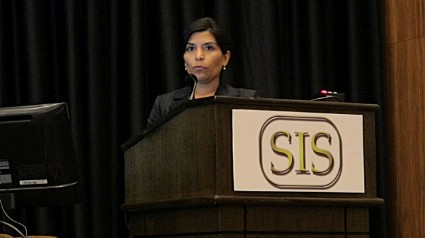User login
BALTIMORE – Implementing a bundle of preventive interventions led to a significant drop in pressure ulcers acquired during hospitalization among high-risk surgical patients, according to a prospective study.
Moreover, the beneficial effect of the program was sustained for more than a year after the program was implemented, reported Dr. Sylvia Martinez of Baylor College of Medicine and the Michael E. DeBakey VA Medical Center in Houston.
Dr. Martinez pointed out that strategies used to prevent hospital-acquired pressure ulcers are not standardized, and that in an effort to improve quality of care, save money, and reduce mortality, the Centers for Medicare & Medicaid Services no longer reimburses medical facilities for stage III and IV hospital-acquired pressure ulcers.
More than 7,000 high-risk patients were included in the study. During the 6 months before the plan was implemented at the medical center, the mean pressure ulcer rate overall was 3.37, dropping to 1.45 during the 6 months after implementation, a significant difference (P = .004). At 18 months, the rate was 0.89. During this time, the mean rates of hospital-acquired pressure ulcers in the entire VA system did not significantly change, ranging from 1.68 to 1.85, Dr. Martinez reported at the annual meeting of the Surgical Infection Society.
The study was done to address the relatively high rate of pressure ulcers in the medical center’s surgical service. Dr. Martinez and her associates evaluated the impact of an evidence-based hospital-acquired pressure ulcer prevention bundle, developed by an interdisciplinary team.
Patients were classified as high risk if they met at least two of four criteria (age greater than 62 years, albumin less than 3.5 g/dL, ASA score greater than 3, and surgery lasting for more than 3 hours).
The components of the program included:
• Comprehensive skin assessment and documentation and identification of any ulcers on admission, transfer, and discharge.
• Use of operating room beds with pressure redistributing mattresses, with careful positioning and padding of pressure points.
• Turning of patients every 2 hours with pressure point relief via wedges, heel pads, and pillows, as well as massages of bony prominences.
• Assessment of patients for pressure ulcers on daily rounds (led by the unit nurse manager) and use of daily checklists in high-risk patients.
The pressure ulcer rate was calculated by the number of discharged acute-care patients with a stage II or greater hospital-acquired pressure ulcer, divided by number patient days in the hospital (the discharge date minus the admission date for all discharged acute-care patients who were hospitalized for at least 48 hours).
During the period studied, 21,377 operations were performed. Almost 5,000 (4,692) were during the 6-month period prior to implementation of the program, from January to June 2012, and 16,685 were done in the 18 months after implementation (including 4,461 during the first 6 months). Overall, 34% of the patients were determined to be at high risk.
The rates dropped significantly in different parts of the surgical service: In the surgical intensive care unit, the rate dropped from 2.93 before implementation to 1.25 at 6 months and 0.86 at 18 months post implementation. In the surgical wards, the rate dropped from 2.93 to 0.83 at 6 months, and was 0.86 at 18 months.
Implementation of this bundle "may decrease hospital-acquired pressure ulcer rates in high risk surgical patients," with sustained lower rates, which "can lead to decreased costs, complications, and length of stay, and improved quality of life for our patients," Dr. Martinez concluded.
Among the study’s limitations were that it was conducted at one hospital and it did not evaluate which elements of the prevention bundle were most important, she said.
Dr. Martinez had no disclosures. The study was funded by the U.S. Department of Veterans Affairs.
BALTIMORE – Implementing a bundle of preventive interventions led to a significant drop in pressure ulcers acquired during hospitalization among high-risk surgical patients, according to a prospective study.
Moreover, the beneficial effect of the program was sustained for more than a year after the program was implemented, reported Dr. Sylvia Martinez of Baylor College of Medicine and the Michael E. DeBakey VA Medical Center in Houston.
Dr. Martinez pointed out that strategies used to prevent hospital-acquired pressure ulcers are not standardized, and that in an effort to improve quality of care, save money, and reduce mortality, the Centers for Medicare & Medicaid Services no longer reimburses medical facilities for stage III and IV hospital-acquired pressure ulcers.
More than 7,000 high-risk patients were included in the study. During the 6 months before the plan was implemented at the medical center, the mean pressure ulcer rate overall was 3.37, dropping to 1.45 during the 6 months after implementation, a significant difference (P = .004). At 18 months, the rate was 0.89. During this time, the mean rates of hospital-acquired pressure ulcers in the entire VA system did not significantly change, ranging from 1.68 to 1.85, Dr. Martinez reported at the annual meeting of the Surgical Infection Society.
The study was done to address the relatively high rate of pressure ulcers in the medical center’s surgical service. Dr. Martinez and her associates evaluated the impact of an evidence-based hospital-acquired pressure ulcer prevention bundle, developed by an interdisciplinary team.
Patients were classified as high risk if they met at least two of four criteria (age greater than 62 years, albumin less than 3.5 g/dL, ASA score greater than 3, and surgery lasting for more than 3 hours).
The components of the program included:
• Comprehensive skin assessment and documentation and identification of any ulcers on admission, transfer, and discharge.
• Use of operating room beds with pressure redistributing mattresses, with careful positioning and padding of pressure points.
• Turning of patients every 2 hours with pressure point relief via wedges, heel pads, and pillows, as well as massages of bony prominences.
• Assessment of patients for pressure ulcers on daily rounds (led by the unit nurse manager) and use of daily checklists in high-risk patients.
The pressure ulcer rate was calculated by the number of discharged acute-care patients with a stage II or greater hospital-acquired pressure ulcer, divided by number patient days in the hospital (the discharge date minus the admission date for all discharged acute-care patients who were hospitalized for at least 48 hours).
During the period studied, 21,377 operations were performed. Almost 5,000 (4,692) were during the 6-month period prior to implementation of the program, from January to June 2012, and 16,685 were done in the 18 months after implementation (including 4,461 during the first 6 months). Overall, 34% of the patients were determined to be at high risk.
The rates dropped significantly in different parts of the surgical service: In the surgical intensive care unit, the rate dropped from 2.93 before implementation to 1.25 at 6 months and 0.86 at 18 months post implementation. In the surgical wards, the rate dropped from 2.93 to 0.83 at 6 months, and was 0.86 at 18 months.
Implementation of this bundle "may decrease hospital-acquired pressure ulcer rates in high risk surgical patients," with sustained lower rates, which "can lead to decreased costs, complications, and length of stay, and improved quality of life for our patients," Dr. Martinez concluded.
Among the study’s limitations were that it was conducted at one hospital and it did not evaluate which elements of the prevention bundle were most important, she said.
Dr. Martinez had no disclosures. The study was funded by the U.S. Department of Veterans Affairs.
BALTIMORE – Implementing a bundle of preventive interventions led to a significant drop in pressure ulcers acquired during hospitalization among high-risk surgical patients, according to a prospective study.
Moreover, the beneficial effect of the program was sustained for more than a year after the program was implemented, reported Dr. Sylvia Martinez of Baylor College of Medicine and the Michael E. DeBakey VA Medical Center in Houston.
Dr. Martinez pointed out that strategies used to prevent hospital-acquired pressure ulcers are not standardized, and that in an effort to improve quality of care, save money, and reduce mortality, the Centers for Medicare & Medicaid Services no longer reimburses medical facilities for stage III and IV hospital-acquired pressure ulcers.
More than 7,000 high-risk patients were included in the study. During the 6 months before the plan was implemented at the medical center, the mean pressure ulcer rate overall was 3.37, dropping to 1.45 during the 6 months after implementation, a significant difference (P = .004). At 18 months, the rate was 0.89. During this time, the mean rates of hospital-acquired pressure ulcers in the entire VA system did not significantly change, ranging from 1.68 to 1.85, Dr. Martinez reported at the annual meeting of the Surgical Infection Society.
The study was done to address the relatively high rate of pressure ulcers in the medical center’s surgical service. Dr. Martinez and her associates evaluated the impact of an evidence-based hospital-acquired pressure ulcer prevention bundle, developed by an interdisciplinary team.
Patients were classified as high risk if they met at least two of four criteria (age greater than 62 years, albumin less than 3.5 g/dL, ASA score greater than 3, and surgery lasting for more than 3 hours).
The components of the program included:
• Comprehensive skin assessment and documentation and identification of any ulcers on admission, transfer, and discharge.
• Use of operating room beds with pressure redistributing mattresses, with careful positioning and padding of pressure points.
• Turning of patients every 2 hours with pressure point relief via wedges, heel pads, and pillows, as well as massages of bony prominences.
• Assessment of patients for pressure ulcers on daily rounds (led by the unit nurse manager) and use of daily checklists in high-risk patients.
The pressure ulcer rate was calculated by the number of discharged acute-care patients with a stage II or greater hospital-acquired pressure ulcer, divided by number patient days in the hospital (the discharge date minus the admission date for all discharged acute-care patients who were hospitalized for at least 48 hours).
During the period studied, 21,377 operations were performed. Almost 5,000 (4,692) were during the 6-month period prior to implementation of the program, from January to June 2012, and 16,685 were done in the 18 months after implementation (including 4,461 during the first 6 months). Overall, 34% of the patients were determined to be at high risk.
The rates dropped significantly in different parts of the surgical service: In the surgical intensive care unit, the rate dropped from 2.93 before implementation to 1.25 at 6 months and 0.86 at 18 months post implementation. In the surgical wards, the rate dropped from 2.93 to 0.83 at 6 months, and was 0.86 at 18 months.
Implementation of this bundle "may decrease hospital-acquired pressure ulcer rates in high risk surgical patients," with sustained lower rates, which "can lead to decreased costs, complications, and length of stay, and improved quality of life for our patients," Dr. Martinez concluded.
Among the study’s limitations were that it was conducted at one hospital and it did not evaluate which elements of the prevention bundle were most important, she said.
Dr. Martinez had no disclosures. The study was funded by the U.S. Department of Veterans Affairs.
AT THE SIS ANNUAL MEETING
Key clinical point: Use preventive measures to reduce pressure ulcers in high-risk surgical patients.
Major finding: The rate of pressure ulcers acquired during hospitalization dropped from 3.37 during the 6 months before a prevention bundle was implemented to 0.89 18 months afterward.
Data source: A prospective study of surgical patients at high risk for developing bedsores, comparing rates of hospital-acquired pressure ulcers 6 and 18 months after preventive interventions with the 6-month period beforehand.
Disclosures: Dr. Martinez had no disclosures. The study was funded by the U.S. Department of Veterans Affairs.

